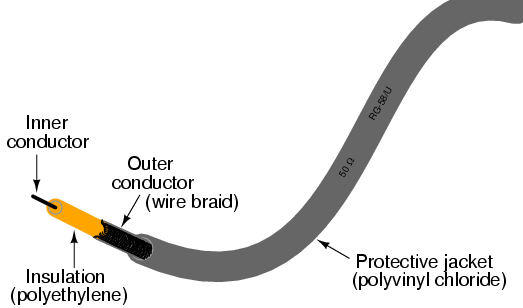A 50-ohm cable?
Early in my explorations of electricity, I
came across a length of coaxial cable with the label
"50 ohms" printed along its outer sheath. Now, coaxial cable
is a two-conductor cable made of a single conductor
surrounded by a braided wire jacket, with a plastic
insulating material separating the two. As such, the outer
(braided) conductor completely surrounds the inner (single
wire) conductor, the two conductors insulated from each
other for the entire length of the cable. This type of
cabling is often used to conduct weak (low-amplitude)
voltage signals, due to its excellent ability to shield such
signals from external interference.

I was mystified by the "50 ohms" label on
this coaxial cable. How could two conductors, insulated from
each other by a relatively thick layer of plastic, have 50
ohms of resistance between them? Measuring resistance
between the outer and inner conductors with my ohmmeter, I
found it to be infinite (open-circuit), just as I would have
expected from two insulated conductors. Measuring each of
the two conductors' resistances from one end of the cable to
the other indicated nearly zero ohms of resistance: again,
exactly what I would have expected from continuous, unbroken
lengths of wire. Nowhere was I able to measure 50 Ω of
resistance on this cable, regardless of which points I
connected my ohmmeter between.
What I didn't understand at the time was the
cable's response to short-duration voltage "pulses" and
high-frequency AC signals. Continuous direct current (DC) --
such as that used by my ohmmeter to check the cable's
resistance -- shows the two conductors to be completely
insulated from each other, with nearly infinite resistance
between the two. However, due to the effects of capacitance
and inductance distributed along the length of the cable,
the cable's response to rapidly-changing voltages is such
that it acts as a finite impedance, drawing current
proportional to an applied voltage. What we would normally
dismiss as being just a pair of wires becomes an important
circuit element in the presence of transient and
high-frequency AC signals, with characteristic properties
all its own. When expressing such properties, we refer to
the wire pair as a transmission line.
This chapter explores transmission line
behavior. Many transmission line effects do not appear in
significant measure in AC circuits of powerline frequency
(50 or 60 Hz), or in continuous DC circuits, and so we
haven't had to concern ourselves with them in our study of
electric circuits thus far. However, in circuits involving
high frequencies and/or extremely long cable lengths, the
effects are very significant. Practical applications of
transmission line effects abound in radio-frequency ("RF")
communication circuitry, including computer networks, and in
low-frequency circuits subject to voltage transients
("surges") such as lightning strikes on power lines. |